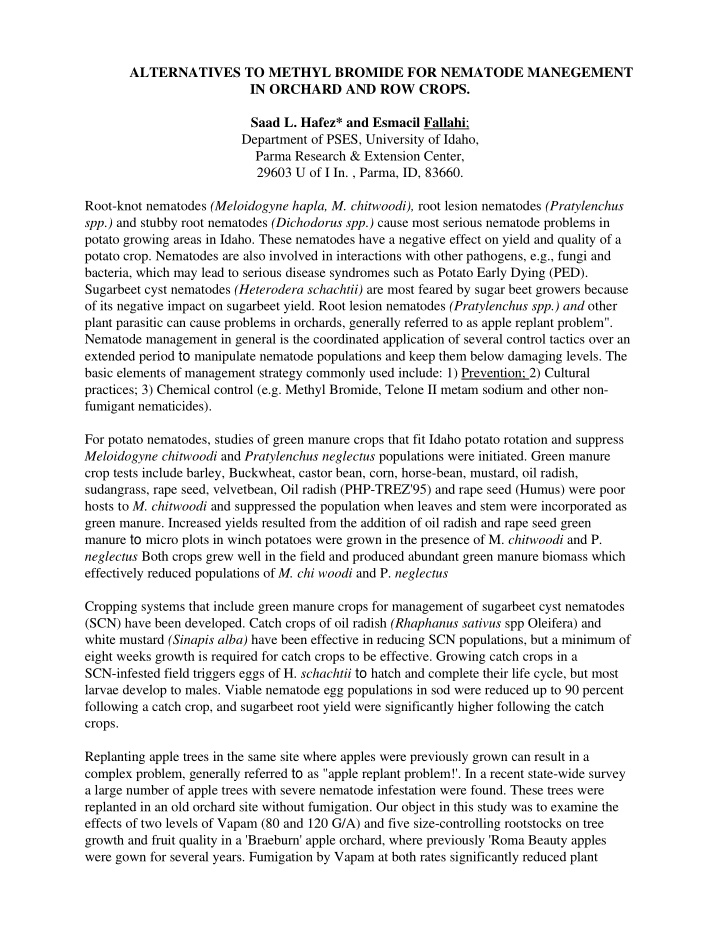



ALTERNATIVES TO METHYL BROMIDE FOR NEMATODE MANEGEMENT IN ORCHARD AND ROW CROPS. Saad L. Hafez* and Esmacil Fallahi ; Department of PSES, University of Idaho, Parma Research & Extension Center, 29603 U of I In. , Parma, ID, 83660. Root-knot nematodes (Meloidogyne hapla, M. chitwoodi), root lesion nematodes (Pratylenchus spp.) and stubby root nematodes (Dichodorus spp.) cause most serious nematode problems in potato growing areas in Idaho. These nematodes have a negative effect on yield and quality of a potato crop. Nematodes are also involved in interactions with other pathogens, e.g., fungi and bacteria, which may lead to serious disease syndromes such as Potato Early Dying (PED). Sugarbeet cyst nematodes (Heterodera schachtii) are most feared by sugar beet growers because of its negative impact on sugarbeet yield. Root lesion nematodes (Pratylenchus spp.) and other plant parasitic can cause problems in orchards, generally referred to as apple replant problem". Nematode management in general is the coordinated application of several control tactics over an extended period to manipulate nematode populations and keep them below damaging levels. The basic elements of management strategy commonly used include: 1) Prevention; 2) Cultural practices; 3) Chemical control (e.g. Methyl Bromide, Telone II metam sodium and other non- fumigant nematicides). For potato nematodes, studies of green manure crops that fit Idaho potato rotation and suppress Meloidogyne chitwoodi and Pratylenchus neglectus populations were initiated. Green manure crop tests include barley, Buckwheat, castor bean, corn, horse-bean, mustard, oil radish, sudangrass, rape seed, velvetbean, Oil radish (PHP-TREZ'95) and rape seed (Humus) were poor hosts to M. chitwoodi and suppressed the population when leaves and stem were incorporated as green manure. Increased yields resulted from the addition of oil radish and rape seed green manure to micro plots in winch potatoes were grown in the presence of M. chitwoodi and P. neglectus Both crops grew well in the field and produced abundant green manure biomass which effectively reduced populations of M. chi woodi and P. neglectus Cropping systems that include green manure crops for management of sugarbeet cyst nematodes (SCN) have been developed. Catch crops of oil radish (Rhaphanus sativus spp Oleifera) and white mustard (Sinapis alba) have been effective in reducing SCN populations, but a minimum of eight weeks growth is required for catch crops to be effective. Growing catch crops in a SCN-infested field triggers eggs of H. schachtii to hatch and complete their life cycle, but most larvae develop to males. Viable nematode egg populations in sod were reduced up to 90 percent following a catch crop, and sugarbeet root yield were significantly higher following the catch crops. Replanting apple trees in the same site where apples were previously grown can result in a complex problem, generally referred to as "apple replant problem!'. In a recent state-wide survey a large number of apple trees with severe nematode infestation were found. These trees were replanted in an old orchard site without fumigation. Our object in this study was to examine the effects of two levels of Vapam (80 and 120 G/A) and five size-controlling rootstocks on tree growth and fruit quality in a 'Braeburn' apple orchard, where previously 'Roma Beauty apples were gown for several years. Fumigation by Vapam at both rates significantly reduced plant
parasitic nematode populations. Severity of nematode reduction was proportional to Vapam rates. Trees which received Vapam treatments had significantly larger trunk cross sectional area (TCSA) than those of control in 1994 (one year after application). Differences between low and high rates of Vapam was not significant in 1994. However two and three years after applications, trees with higher Vapam rates had significantly higher TCSA than those with lower Vapam rates and trees in both of these treatments had higher TCSA than those in control. Yield per tree, yield efficiency and hurt sizes in both rates of Vapam treated trees were greater than those in control in 1995 and 1996. 6-1
Trees with both rates of Vapam had a similar yield efficiency in both 1995 and 1996, although yield per tree at highest rate of Vapam was significantly higher than the lowest rate. In 1995, no difference existed in fruit size. In 1996, however, fruit sizes in both Vapam treatments were significantly larger than those of the control. Fruit color and sunburn were not affected by the rate of Vapam application. Leaf N in the control trees was higher than those of Vapam treated trees in 1995, but no significant differences existed in 1996. Significantly higher dry matter and larger leaves of Vapam treated trees than those of control, perhaps resulted in a higher dilution effect and thus, lower N. Trees on NO and M.26 had significantly lower TCSA than all other root-stocks in 1995 and 1996 than those on MM 106 and M. 111 in 1994. Trees on M.9 and M.26 also were significantly more precocious and had more yield per tree and yield efficiency than all other rootstocks in 1995 and 1996. 6-2
Recommend
More recommend